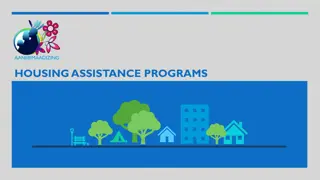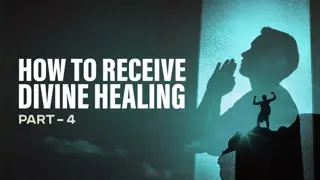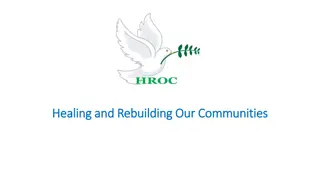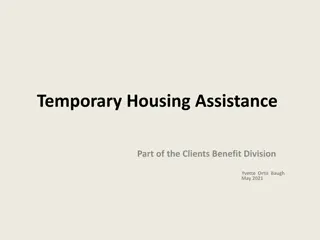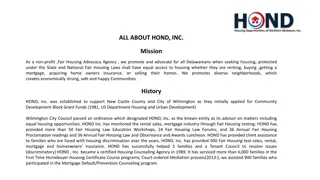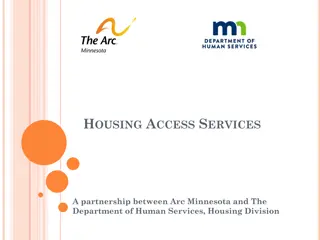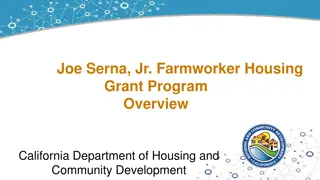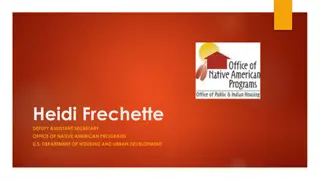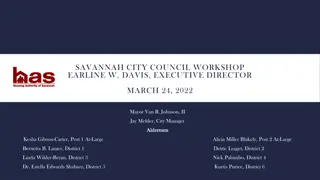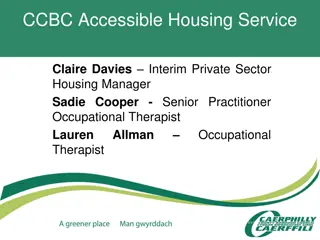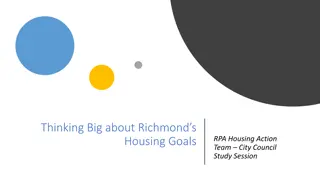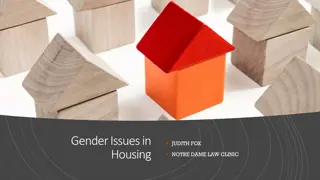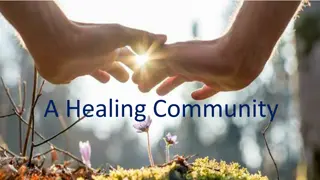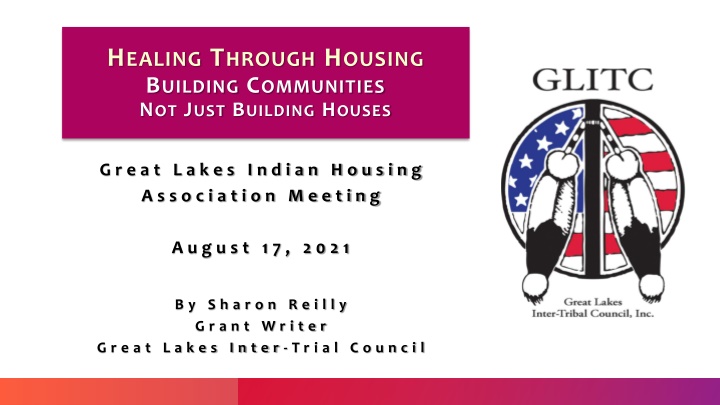
Healing Through Housing Building Communities and Tribal Advocacy
Explore the initiative of Healing Through Housing, promoting community development and tribal advocacy. Learn about the priorities outlined by GLITC including housing, mental health, and economic development. Discover insights on Maslow's Hierarchy of Needs and the unique cultural perspectives of the Blackfoot society. This comprehensive look at community-oriented cultures and initiatives emphasizes a holistic approach to social well-being.
Uploaded on | 2 Views
Download Presentation

Please find below an Image/Link to download the presentation.
The content on the website is provided AS IS for your information and personal use only. It may not be sold, licensed, or shared on other websites without obtaining consent from the author. If you encounter any issues during the download, it is possible that the publisher has removed the file from their server.
You are allowed to download the files provided on this website for personal or commercial use, subject to the condition that they are used lawfully. All files are the property of their respective owners.
The content on the website is provided AS IS for your information and personal use only. It may not be sold, licensed, or shared on other websites without obtaining consent from the author.
E N D
Presentation Transcript
HEALING THROUGH HOUSING BUILDING COMMUNITIES NOT JUST BUILDING HOUSES G r e a t L a k e s I n d i a n H o u s i n g A s s o c i a t i o n M e e t i n g A u g u s t 1 7 , 2 0 2 1 B y S h a r o n R e i l l y G r a n t W r i t e r G r e a t L a k e s I n t e r - T r i a l C o u n c i l
HEALING THROUGH HOUSING BUILDING COMMUNITIES NOT JUST BUILDING HOUSES Vision GLITC shall be a diligent advocate for the advancement and promotion of Tribal Nations and Communities by honoring the Seventh- Generation perspective. Mission To enhance the quality of life for all Native People Values Culture, Respect, Diversity, Collaboration, Teamwork, Stewardship
GLITC PRIORITIES 2019 Priorities Identified by BOD: Housing Drug Crisis Mental Behavioral Health Economic Development Healthcare Emergency Management & Planning GLITC Strategic Plan Executive summary available online https://www.glitc.org/2020/wp-content/uploads/2020/06/GLITC_-Strategic_Planning_Executive_Summary_2019.pdf
HIERARCHY OF NEEDS Modern Psychology and the Principle of Hierarchy of Needs Maslow s Hierarchy of Needs (1943) How did Maslow arrive at his Hierarchy?
1938 Abraham Maslow (far right) at the Siksika Reserve (Blackfoot), Alberta Canada with Fritz Lenel (German visitor), Howard McMaster (Blackfoot interpreter)anthropologists Jane Richardson (later Hanks) and Lucien Hanks
MASLOWS UNPUBLISHED PAPER ON THE BLACKFOOT Children are not humiliated by their parents as they are in our society. Women are not humiliated by men. Inferior men are not humiliated by superior men, nor are the poor humiliated by the rich. (Security) evidenced by dignity and friendliness little insecurity, suspicion, envy, jealousy, antagonism and hostility or anxiety. The Blackfoot character has little drive for power, not seek ascendancy over other people. A leader does not use it to dominate. The Blackfoot are clearly a society in which those in power are expected to help those who have given them their power; power involves reciprocal duties to the society that bestowed it. Sidney Stone Brown, PsyD, member of the Blackfeet Nation of Montana (APA Conference 2016)
Community-oriented First Nation Cultures Individual-oriented European-American Cultures Maslow s Model Individual focused Self-Actualization at the TOP
Community-oriented First Nation Cultures Individual-oriented European-American Cultures Maslow s Model Individual focused Self-Actualization at the TOP First Nations Perspective Focus is on Community Self-Actualization at the Base Source: This slide was presented by University of Alberta professor Cathy Blackstock at the 2014 conference of the National Indian Child Welfare Association. It compares and contrasts Western and First Nations perspectives.
BUILDING COMMUNITIES TO LEAVE NO ONE BEHIND Whereas mainstream American narratives focus on the individual, the Blackfoot/Indigenous way of life offers an alternative resulting in a community that leaves no one behind T E J U R AV I L O C H A N
First Nations Indigenous Model Inverted Model SELF-ACTUALIZATION Maslow s hierarchy ends with self-actualization, Indigenous model begins with Self-Actualization We are each born into the world as a spark of divinity, with a great purpose embedded in us WE ARRIVEON EARTH SELF-ACTUALIZED Interpretations by Dr. Sidney Brown, Behavioral Health Director at Navajo Regional Behavioral Health Center
First Nations Indigenous Model Community - Belonging After we re born, imbued with a divine purpose, the tribe is there to love and care for us. Basic Needs & Safety Maslow s Hierarchy Maslow s model, we find love and belonging only AFTER attending to our basic needs and safety
Community Actualization Our tribe or community is the means through which we are fed, housed, clothed, and protected. The tribe knows how to survive on the land and uses that knowledge and skill to care for us. Community actualization assures each member of the tribe manifests their purpose and has their basic needs met COMMUNITY ACTUALIZATION
Community Actualization An actualized human being Is to be of service to our communities as independent webs of humanity Interpretations by Dr. Sidney Brown Behavioral Health Director at Navajo Regional Behavioral Health Center
Cultural Perpetuity Above community reaching toward the expansiveness of the sky lies cultural perpetuity Sustaining cultural values across space, time and generations Dr. Sidney Brown
Cultural Perpetuity Each member of the tribe will one day be gone Passing on their knowledge of how to achieve community actualization and harmony with the land and other peoples, gives rise to and endurance of the Indigenous way of life, or CULTURALPERPETUITY Dr. Sidney Brown
Breath of Life Indigenous Model Terry Cross, PhD Founder National Indian Child Welfare Association (NICWA) Source: This slide was presented by University of Alberta professor Cathy Blackstock at the 2014 conference of the National Indian Child Welfare Association. It compares and contrasts Western and First Nations perspectives.]
SOCIAL DETERMINANTSOF HEALTH FIVE DOMAINS SDOH - Domains Healthcare Access & Quality Neighborhood & Built Environment Social and Community Context Economic Stability Education Access & Quality
HOUSING A Social Determinant of Health Housing Stability Quality Safety Affordability Characteristics of Neighborhoods
Housing Challenges Populations Impacted Quality & Quantity of Housing Limited Inventory on reservations and off Impacts of Natural Disasters Plan for Sustainability Populations Impacted Housing Workforce, Homeless, Underemployed, People with Substance Abuse, Large Families, People Living in Flood Zones, Elders EVERYONE
Identifying Tribes Vision for Housing Understanding Each Tribal Nation s Needs Community-Based and Participatory Strategic Planning Understand community s NEEDS& Tribe s VISION Identify EXISTING CAPACITY within each Tribal Community EXPAND CAPACITY with local and regional community Partners FILL THE GAPS with programs & services, and plan for SUSTAINABILITY Integrate GLITC strategic ACTION PLANS with each Tribal Community
HEALING THROUGH HOUSING DISCUSSION Vision what impact do you want to achieve in your Tribe Support Services Needed how can current GLITC Programs or new programs assist Partners attracting new funding resources and expanding capacity Sustainability Social Enterprise Development SDOH / Priorities how is Housing linked to other SDOH and other GLITC Priorities
HEALING THROUGH HOUSING GLITC CONTACTS Sharon Reilly Grant Writer (715) 588-1045 sreilly@glitc.org Bryan Bainbridge CEO (715) 588-1026 bbainbridge@glitc.org
HEALING THROUGH HOUSING THANK YOU! M iig w e c h M iig w e c h W a w a e n o n W a w a e n o n i gwshe gweyen i gwshe gweyen yaw^ ko yaw^ ko P P inagig inagigii M eegwetch M eegwetch

